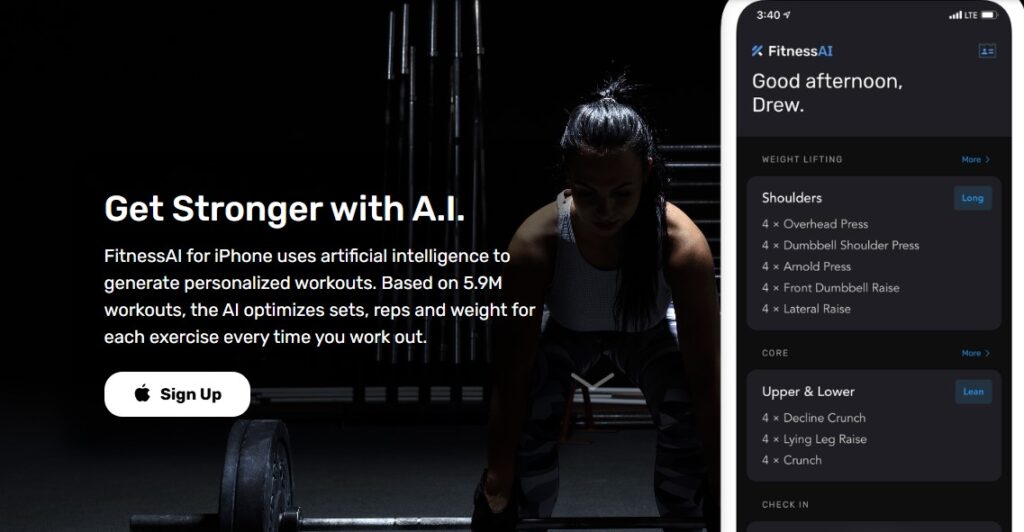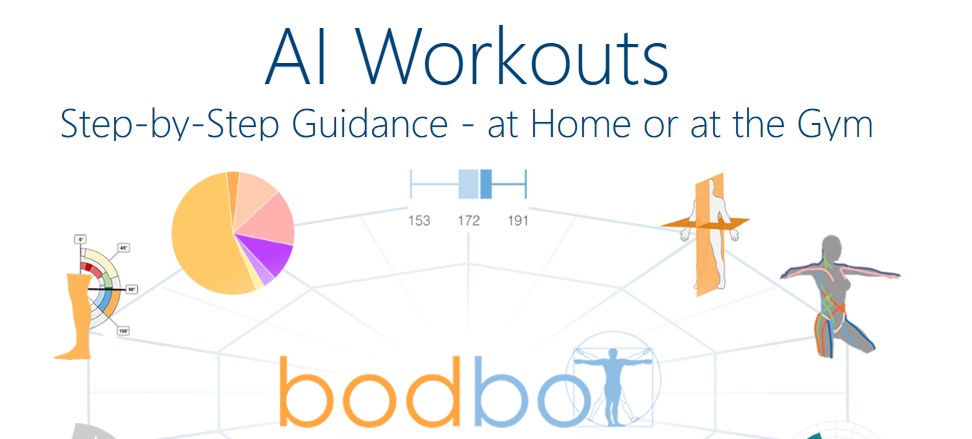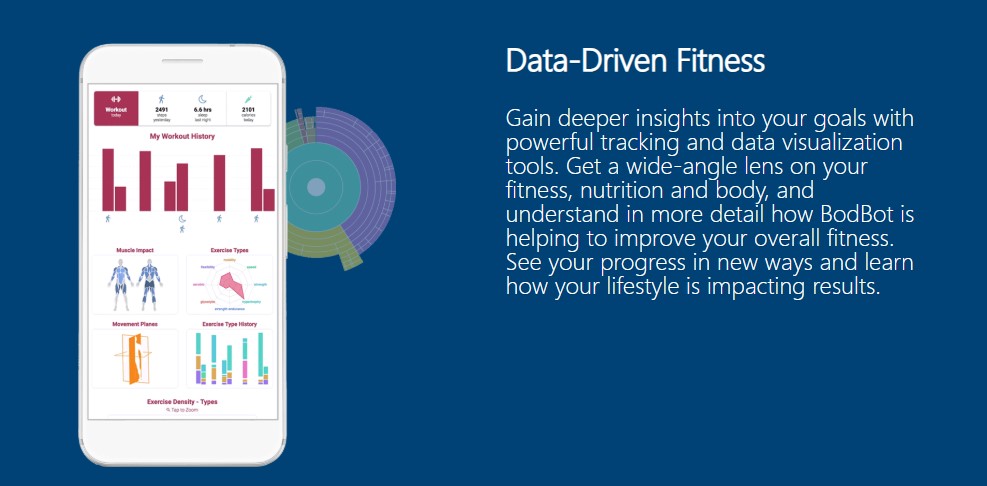FitnessAI vs BodBot: Which AI Workout App Wins in 2024?
Welcome to the ultimate showdown: FitnessAI vs BodBot! It’s no secret that AI-driven workout apps are revolutionizing how we stay…

Welcome to the ultimate showdown: FitnessAI vs BodBot!
It’s no secret that AI-driven workout apps are revolutionizing how we stay active—over 65% of people now seek digital tools for personalized fitness guidance.
From adaptive routines to goal-specific recommendations, these platforms have leveled up the way we train. Let’s explore the unique features, user experiences, and pricing structures of these two power players.
As a long-time fitness enthusiast, I’m here to guide you through their differences with an upbeat tone, so you can confidently choose the app that best aligns with your goals and lifestyle.
Understanding the Core Features of FitnessAI vs BodBot
I remember when I first tried FitnessAI, I felt skeptical about trusting an app to pick my sets and reps. Yet, it turned out to be super impressive because its machine learning fitness algorithms seemed to understand exactly when to push me harder and when to let me recover.

FitnessAI’s approach to personalized strength training is what I like most—it really leans into progressive overload coaching, carefully increasing the weight or reps just enough so I don’t hit a plateau too early.
BodBot, on the other hand, reminds me of a more well-rounded fitness buddy, not just a weightlifting coach. It’s got this huge intuitive exercise library that feels tailored to different goals, whether you’re building muscle, improving cardio, or just getting more flexible.
The idea here is that BodBot offers a whole spectrum of adaptive workout routines, covering everything from bodyweight exercise customization to heavier gym lifts, all guided by data-driven workout adjustments.
One cool thing I noticed is how these apps break down your workouts with workout tracking analytics and body composition metrics.
With FitnessAI, I’d often see charts and graphs showing how my strength increased over time, which really boosted my motivation.
BodBot is also pretty darn good at keeping a log, providing goal-specific training programs and suggestions like reducing rest time or adding a certain cardio routine if it thinks you need more endurance. Both apps act like your own digital personal trainer, but the main difference is that FitnessAI is more laser-focused on incremental strength gains, while BodBot is like having an all-in-one fitness toolbox, handling flexibility, HIIT routines integration, and even some nutritional guidance compatibility if you connect it with other platforms.
Honestly, I made the mistake early on of ignoring BodBot’s variety. I assumed it wouldn’t work as well for serious strength building, but its machine learning fitness algorithms are still at play. I tried some of BodBot’s customizable workout plans, and it surprised me by shifting recommendations based on my feedback and results. Whether you need cardio conditioning routines, want to focus on a single muscle group, or just need a gentle session after a tough workout, BodBot adjusts like magic.

To give you a quick snapshot, here’s a simple comparison table based on my experience:
| Feature | FitnessAI | BodBot |
|---|---|---|
| Primary Focus | Strength & Progressive Overload | All-around Fitness (Strength, Cardio, Mobility) |
| Algorithm Style | Weight-focused, data-driven sets & reps | Adaptive routines across multiple exercise types |
| Variety of Workouts | Primarily strength training exercises | Strength, cardio, flexibility, HIIT, bodyweight |
| Progress Tracking | Strength gains, volume increases | Endurance, mobility, body composition changes |
H2: User Experience and Interface Comparison
Now, let’s talk about what it’s like to actually use these apps day-to-day. FitnessAI keeps things straightforward: from the moment you open it, the user-friendly fitness interface leads you straight to your planned workout. I love how its intelligent exercise recommendations appear clearly, and the navigation menu is clean, making it easy to find my previous sessions, check my progression tracking charts, and review workout intensity adjustments without getting lost.
BodBot feels more like a fitness playground. The interface isn’t messy, but it’s got more layers. I remember spending a good 10 minutes exploring all the settings—like the flexible training schedules, the community fitness engagement options, and the trainer-led video tutorials.
Sometimes I find myself making small tweaks, like changing the workout length or the type of equipment I’m using, and BodBot handles it without a hitch. It even suggests peak performance insights and gives me access to a broader set of goal-specific training programs that aren’t buried under a million sub-menus.
Both apps integrate nicely with wearable device integration—my smartwatch synced up just fine. FitnessAI’s syncing was pretty much automatic, while BodBot gave a few extra steps, but once connected, I got real-time performance feedback on my wrist. Another standout is how BodBot’s interface encourages trying different workout tracking analytics, like comparing past sessions or analyzing my energy expenditure calculations.
FitnessAI is a bit more minimalistic, focusing on the strength metrics, while BodBot can feel a little more complex. But if you appreciate lots of detail, BodBot’s immersive training experience is worth the extra poking around.
I learned the hard way that if I’m short on time and want a no-nonsense lift, I open FitnessAI. If I’m curious and want to experiment with new exercises or see how my cardio stacks up against my strength training, I open BodBot. Each app’s in-app motivational features kept me going; FitnessAI sends simple nudges, while BodBot gives more varied suggestions like “Try a shorter HIIT session today!” Ultimately, the cross-platform fitness solutions offered by both mean I’m never stuck on one device, and I can track my workouts from my phone at the gym or on my tablet at home.
H2: Integrations and Compatibility
I remember the first time I tried syncing FitnessAI with my smartwatch. I expected a complicated mess, but it actually recognized my device right away.
Even better, it started providing real-time performance feedback on my wrist, like how many sets I had left and how well I was managing my energy expenditure calculations during each session. It’s not just about hardware, though. FitnessAI also plays pretty nice with other platforms: I’ve exported my logs to spreadsheets to share with a nutrition coach, and the cross-platform fitness solutions mean I can switch between my phone and tablet without losing data. If you’re a bit of a data nerd like me, you’ll love how smooth and straightforward it all feels.
BodBot is different, but not in a bad way. Its wearable device integration is good, but I did have to jump through a few hoops at first. After fiddling for a couple of minutes, I got it linked to my fitness tracker, and from there, BodBot started providing some cool insights, like how changing my workout time of day affected my peak performance insights.
One awesome thing about BodBot is how it’s basically a big party that likes everyone: it works well with third-party apps, and the nutritional guidance compatibility feature really shines if you combine BodBot with a calorie-tracking app. Need to sync to Google Fit or Apple Health? No problem. BodBot felt like the social butterfly of fitness apps, connecting with everything in my digital ecosystem.
To make things clearer, here’s a quick chart of integration features based on my experience:
| Integration & Compatibility | FitnessAI | BodBot |
|---|---|---|
| Wearable Devices | Easy sync with most smartwatches | Works with major trackers, a few extra steps to set up |
| Export Options | Straightforward spreadsheets, progress logs | Flexible data export, easy to share with coaches |
| Third-Party Nutrition Apps | Limited direct link, must export/import data | Smooth compatibility (integrates quickly with food apps) |
| Multi-Device Use | Seamless: phone, tablet, and web versions | Also cross-platform, just a bit more complex to navigate |
In short, if you like to keep everything simple and in-house, FitnessAI does the trick. If you’re more about connecting with multiple tools and services, BodBot’s broad reach might be your jam.
Pricing, Free Trials, and Value for Money

Let’s be honest, price always matters. When I first compared these apps, FitnessAI seemed a tad pricier, but I also found occasional deals. I got a free trial that lasted long enough for me to see improvements in my progressive overload coaching, and that made me feel better about forking over cash. The monthly subscription plan wasn’t bad, but I personally went with the annual membership discount to save some bucks.
BodBot, meanwhile, gives you a pretty generous free trial. I remember being surprised at how many features they let me play with before asking for a dime. After the trial, the cost was slightly lower than FitnessAI’s premium tier. Plus, BodBot’s additional perks, like access to trainer-led video tutorials and broader customizable workout plans, made me feel I was getting good ROI on results.
If you’re still on the fence, check out any seasonal promotions—once, I nabbed a sweet deal around the New Year’s fitness rush.
In terms of whether it’s worth the money, FitnessAI is like a high-end gym membership that’s laser-focused on delivering consistent strength gains. BodBot is more of a community center that offers a bunch of classes: you can do cardio, HIIT, strength training, and even some mobility work, making it feel like you’re getting more for your buck if you crave variety. Sure, either option can feel like a big investment, but considering how these AI fitness apps can replace a pricey personal trainer, it’s not too shabby.
Who Should Choose FitnessAI vs BodBot?
Now, if you’re just starting out—like, you still mix up a dumbbell with a kettlebell—I’d lean towards BodBot. Its beginner-friendly fitness support feels super welcoming. You get step-by-step guides, form cues, and a variety of easy routines to build confidence without feeling overwhelmed. It also helps beginners understand different muscle group focus plans and experiment a little with bodyweight exercise customization before moving on to heavier lifts.
If you’re more experienced, say you’ve been hitting the gym for a while and really want to nail those micro-progressions in your strength routine, FitnessAI is gold. I loved how it got me to lift consistently heavier over time, helping me see real long-term fitness progress in metrics like total volume lifted and incremental strength gains. For the intermediate fitness programming crowd, FitnessAI helps you push past plateaus by adjusting intensity, rest intervals, and exercises so you’re always improving.
For those advanced athletes who’ve been around the block: BodBot might surprise you. While FitnessAI keeps it simple and strong, BodBot lets you fine-tune nearly every aspect of your training—timing, exercise types, intensity patterns, and more. If you get bored easily, BodBot’s variety will keep things fresh. And if you’re a data freak, BodBot’s advanced user analytics and ability to incorporate nutritional data from third-party apps can really help dial in performance across multiple fronts.
In the end, it all comes down to what you want. FitnessAI vs BodBot isn’t about picking a winner; it’s about picking what wins for you. If you know you’re all about strength and minimal fuss, choose FitnessAI. If you want a one-stop shop that covers everything from HIIT routines integration to endurance-building programs and maybe a bit of community feel, BodBot’s got your back. Just try them both out, trust your gut feeling, and watch your fitness journey unfold on your terms.
Final Thoughts and Personal Takeaways
Over time, I’ve learned that no single AI fitness app holds a magic key to everyone’s goals. I’ve messed up by trying too many tools at once, confusing my training routine until I didn’t know which app was actually helping me. When I stripped everything back and focused on the basics—clear goals, consistent effort, and a reliable digital personal trainer—I realized both FitnessAI and BodBot have distinct strengths worth considering.
For me, FitnessAI’s gift lies in its simplicity and consistent progression. I remember hitting a point where I was stuck at a 75-pound bench press for weeks. After using FitnessAI for about two months, I noticed I was gradually adding 5-10 pounds every couple of weeks, without feeling overwhelmed or risking bad form. Those incremental strength gains reminded me that the app’s progressive overload coaching, combined with its data-driven approach, can really work wonders for intermediate to advanced users who love seeing those neat strength charts inch upwards.
On the flip side, BodBot is like that all-encompassing personal trainer who says, “Hey, you’re not just a lifter—you’re a whole person who could use some balance.” When I felt bored or fatigued from the same old lifting routine, BodBot’s goal-specific training programs and flexible training schedules offered something fresh. Maybe one day I’d focus on a HIIT routine integration to rev up my metabolism, and on a lazy Sunday, I’d choose a gentle mobility session that helped me recover. Its wide variety of exercises and adaptive suggestions taught me that holistic fitness improvements—like better endurance, improved flexibility, and enhanced body composition—come from mixing things up.
I also discovered that using BodBot alongside a nutritional guidance compatibility tool helped me refine my eating habits.
I’m not a dietician, but pairing an app that can tweak my workouts with another platform tracking my protein intake made the journey feel more complete.
On the other hand, FitnessAI’s simple export function let me share my strength progress with a personal coach who gave me tips on technique. Between these two, I ended up with a digital “team” helping me fine-tune my lifestyle.
FitnessAI vs BodBot: Summing Up
In the end, don’t be afraid to try both. Grab a free trial, see how each integrates with your wearables, play around with their workouts, and pay attention to how you feel. If something doesn’t vibe with you, ditch it. If it does, lean into that progress and keep exploring. It’s all about finding a tool that aligns with your personal journey, keeping you engaged, and motivating you to push a little harder than you did yesterday. Trust me, your future, fitter self will thank you.
